Oxidation of CO and Methanol on Pd-Ni Catalysts Supported on Different Chemically-Treated Carbon Nanofibers
Abstract
:1. Introduction
2. Results
2.1. Chemical and Physical Properties of Carbon Supports
2.2. Physical Characterization of Catalysts
2.3. Electrochemical Activity Towards CO and Methanol
3. Discussion
4. Materials and Methods
4.1. Carbon Supports
4.2. Preparation of Pd-Ni Catalysts
4.3. Physical Characterization
4.4. Electrochemical Characterization
5. Conclusions
Acknowledgments
Author Contributions
Conflicts of Interest
References
- Wang, Z.B.; Yin, G.P.; Shi, P.F. Effects of ozone treatment of carbon support on Pt-Ru/C catalysts performance for direct methanol fuel cell. Carbon 2006, 44, 133–140. [Google Scholar] [CrossRef]
- Patra, S.; Dash, S.; Anand, V.; Nimishab, C.S.; Rao, G.M.; Munichandraiah, N. Electrochemical co-deposition of bimetallic Pt-Ru nanoclusters dispersed on poly(3,4-ethylenedioxythiophene) and electrocatalytic behavior for methanol oxidation. Mater. Sci. Eng. B 2011, 176, 785–791. [Google Scholar] [CrossRef]
- Zhao, Y.; Zhan, L.; Tian, J.; Nie, S.; Ning, Z. Enhanced electrocatalytic oxidation of methanol on Pd/polypirrole-graphene in alkaline medium. Electrochim. Acta 2011, 56, 1967–1972. [Google Scholar] [CrossRef]
- Gasteiger, H.A.; Kocha, S.S.; Sompalli, B.; Wagner, F.T. Activity benchmarks and requirements for Pt, Pt-alloy and non-Pt oxygen reduction catalysts for PEMFCs. Appl. Catal. B 2005, 56, 9–35. [Google Scholar] [CrossRef]
- Vengatesan, S.; Kim, H.J.; Kim, S.K.; Oh, I.H.; Lee, S.Y.; Cho, E.; Ha, H.Y.; Lim, T.H. High dispersion platinum catalyst using mesoporous carbon support for fuel cells. Electrochim. Acta 2008, 54, 856–861. [Google Scholar] [CrossRef]
- Watanabe, M.; Sei, H.; Stonehart, P. The influence of platinum crystallite size on the electroreduction of oxygen. J. Electroanal. Chem. 1989, 261, 375–387. [Google Scholar] [CrossRef]
- Kinoshita, K. Particle size effects for oxygen reduction on highly dispersed platinum in acid electrolytes. J. Electrochem. Soc. 1990, 137, 845–848. [Google Scholar] [CrossRef]
- Yahikozawa, K.; Fujii, Y.; Matsuda, Y.; Nishimura, K.; Takasu, Y. Electrocatalytic properties of ultrafine platinum particles for oxidation of methanol and formic acid in aqueous solutions. Electrochim. Acta 1991, 36, 973–978. [Google Scholar] [CrossRef]
- Brouzgoua, A.; Song, S.Q.; Tsiakaras, P. Low and non-platinum electrocatalysts for PEMFCs: Current status, challenges and prospects. Appl. Catal. B 2012, 127, 371–388. [Google Scholar] [CrossRef]
- Hassan, A.; Paganin, V.A.; Carreras, A.; Ticianelli, E.A. Molybdenum carbide-based electrocatalysts for CO tolerance in proton exchange membrane fuel cell anodes. Electrochim. Acta 2014, 142, 307–316. [Google Scholar] [CrossRef]
- Zellner, M.B.; Chen, J.G. Surface science and electrochemical studies of WC and W2C PVD films as potential electrocatalysts. Catal. Today 2005, 99, 299–307. [Google Scholar] [CrossRef]
- Christian, J.B.; Smith, S.P.E.; Whittingham, M.S.; Abruña, H.D. Tungsten based electrocatalyst for fuel cell applications. Electrochem. Comm. 2007, 9, 2128–2132. [Google Scholar] [CrossRef]
- Izhar, S.; Nagai, M. Cobalt molybdenum carbides as anode electrocatalyst for proton exchange membrane fuel cell. J. Power Sources 2008, 182, 52–60. [Google Scholar] [CrossRef]
- Zhang, D.; Chi, D.; Okajima, T.; Ohsaka, T. Catalytic activity of dual catalysts system based on nano-manganese oxide and cobalt octacyanophthalocyanine toward four electron reduction of oxygen in alkaline media. Electrochim. Acta 2007, 52, 5400–5406. [Google Scholar] [CrossRef]
- Lima, F.H.B.; Calegaro, M.L.; Ticianelli, E.A. Electrocatalytic activity of manganese oxides prepared by thermal decomposition for oxygen reduction. Electrochim. Acta 2007, 52, 3732–3738. [Google Scholar] [CrossRef]
- Médard, C.; Lefèvre, M.; Dodelet, J.P.; Lindbergh, G. Oxygen reduction by Fe-based catalysts in PEM fuel cell conditions: Activity and selectivity of the catalysts obtained with two Fe precursors and various carbon supports. Electrochim. Acta 2006, 51, 3202–3213. [Google Scholar] [CrossRef]
- Zhong, H.X.; Zhang, H.M.; Hu, J.W.; Yi, B.L. A novel non-noble electrocatalyst for PEM fuel cell based on molybdenum nitride. Electrochem. Comm. 2006, 8, 707–712. [Google Scholar] [CrossRef]
- Rasten, E.; Hagen, G.; Tunold, R. Electrocatalysis in water electrolysis with solid polymer electrolyte. Electrochim. Acta 2003, 48, 3945–3952. [Google Scholar] [CrossRef]
- Amin, R.S.; Abdel Hameed, R.M.; El-Khatiba, K.M. Microwave heated synthesis of carbon supported Pd, Ni and Pd–Ni nanoparticles for methanol oxidation in KOH solution. Appl. Catal. B 2014, 148, 557–567. [Google Scholar] [CrossRef]
- Jin, C.; Sun, X.; Chen, Z.; Dong, R. Electrocatalytic activity of PdNi/C catalysts for allyl alcohol oxidation in alkaline solution. Mater. Chem. Phys. 2012, 135, 433–437. [Google Scholar] [CrossRef]
- Amin, R.S.; Abdel Hameed, R.M.; El-Khatib, K.M.; Elsayed Youssef, M. Electrocatalytic activity of nanostructured Ni and Pd-Ni on Vulcan XC-72R carbon black for methanol oxidation in alkaline medium. Int. J. Hydrogen Energy 2014, 39, 2026–2041. [Google Scholar] [CrossRef]
- Lim, F.C.H.; Zhang, J.; Jin, H.M.; Sullivan, M.B.; Wu, P. A density functional theory study of CO oxidation on Pd-Ni alloy with sandwich structure. Appl. Catal. A 2013, 451, 79–85. [Google Scholar] [CrossRef]
- Zheng, J.N.; He, L.L.; Chen, F.Y.; Wang, A.J.; Xue, M.W.; Feng, J.J. A facile general strategy for synthesis of palladium-based bimetallic alloyed nanodendrites with enhanced electrocatalytic performance for methanol and ethylene glycol oxidation. J. Mater. Chem. A 2014, 2, 12899–12906. [Google Scholar] [CrossRef]
- Qi, Z.; Geng, H.; Wang, X.; Zhao, C.; Ji, H.; Zhang, C.; Xu, J.; Zhang, Z. Novel crystalline PdNi alloy catalysts for methanol and ethanol electro-oxidation in alkaline media. J. Power Sources 2011, 196, 5823–5828. [Google Scholar] [CrossRef]
- Ding, K.; Yang, H.; Cao, Y.; Zheng, C.; Rapole, S.B.; Guo, Z. Using ionic liquid as the solvent to prepare Pd-Ni bimetallic nanoparticles by a pyrolysis method for ethanol oxidation reaction. Mat. Chem. Phys. 2013, 142, 403–411. [Google Scholar] [CrossRef]
- Ramulifho, T.; Ozoemena, K.I.; Modibedi, R.M.; Jafta, C.J.; Mathe, M.K. Electrocatalytic oxidation of ethylene glycol at palladium-bimetallic nanocatalysts (PdSn and PdNi) supported on sulfonate-functionalised multi-walled carbon nanotubes. J. Electroanal. Chem. 2013, 692, 26–30. [Google Scholar] [CrossRef]
- Li, R.; Wei, Z.; Huang, T.; Yu, A. Ultrasonic-assisted synthesis of Pd-Ni alloy catalysts supported on multi-walled carbon nanotubes for formic acid electrooxidation. Electrochim. Acta 2011, 56, 6860–6865. [Google Scholar] [CrossRef]
- Van Dam, H.E.; Van Bekkum, H. Preparation of platinum on activated carbon. J. Catal. 1991, 131, 335–349. [Google Scholar] [CrossRef]
- Gallezot, P.; Richard, D.; Bergeret, G. Low-nuclearity platinum clusters supported on graphite. ACS Symp. Ser. 1990, 437, 150–159. [Google Scholar]
- Ott, L.S.; Finke, R.G. Transition-metal nanocluster stabilization for catalysis: A critical review of ranking methods and putative stabilizers. Coord. Chem. Rev. 2007, 251, 1075–1100. [Google Scholar] [CrossRef]
- Yang, X.; Zheng, J.; Zhen, M.; Meng, X.; Jiang, F.; Wang, T.; Shu, C.; Jiang, L.; Wang, C. A linear molecule functionalized multi-walled carbon nanotubes with well dispersed PtRu nanoparticles for ethanol electro-oxidation. Appl. Catal. B 2012, 121–122, 57–64. [Google Scholar] [CrossRef]
- Jin, X.; He, B.; Miao, J.; Yuan, J.; Zhang, Q.; Niu, L. Stabilization and dispersion of PtRu and Pt nanoparticles on multiwalled carbon nanotubes using phosphomolybdic acid, and the use of the resulting materials in a direct methanol fuel cell. Carbon 2012, 50, 3083–3091. [Google Scholar] [CrossRef]
- Cheng, Y.; Jiang, S.P. Highly effective and CO-tolerant PtRu electrocatalysts supported on poly(ethyleneimine) functionalized carbon nanotubes for direct methanol fuel cells. Electrochim. Acta 2013, 99, 124–132. [Google Scholar] [CrossRef]
- Tang, H.; Chen, J.H.; Huang, Z.P.; Wang, D.Z.; Ren, Z.F.; Nie, L.H.; Kuang, Y.F.; Yao, S.Z. High dispersion and electrocatalytic properties of platinum on well-aligned carbon nanotube arrays. Carbon 2004, 42, 191–197. [Google Scholar] [CrossRef]
- Yang, R.; Qiu, X.; Zhang, H.; Li, J.; Zhu, W.; Wang, Z.; Huang, X.; Chen, L. Monodispersed hard carbon spherules as a catalyst support for the electrooxidation of methanol. Carbon 2005, 43, 11–16. [Google Scholar] [CrossRef]
- Liu, Y.C.; Qiu, X.P.; Huang, Y.Q.; Zhu, W.T. Methanol electro-oxidation on mesocarbon microbead supported Pt catalysts. Carbon 2002, 40, 2375–2380. [Google Scholar] [CrossRef]
- Liu, Y.C.; Qiu, X.P.; Huang, Y.Q.; Zhu, W.T. Mesocarbon microbeads supported Pt-Ru catalysts for electrochemical oxidation of methanol. J. Power Sources 2002, 111, 160–164. [Google Scholar] [CrossRef]
- Calderón, J.C.; Mahata, N.; Pereira, M.F.R.; Figueiredo, J.L.; Fernandes, V.R.; Rangel, C.M.; Calvillo, L.; Lázaro, M.J.; Pastor, E. Pt-Ru catalysts supported on carbon xerogels for PEM fuel cells. Int. J. Hydrogen Energy 2012, 37, 7200–7211. [Google Scholar] [CrossRef]
- Job, N.; Marie, J.; Lambert, S.; Berthon-Fabry, S.; Achard, P. Carbon xerogels as catalyst supports for PEM fuel cell cathode. Energ. Convers. Manag. 2008, 49, 2461–2470. [Google Scholar] [CrossRef]
- Calvillo, L.; Lázaro, M.J.; Bordejé, E.G.; Moliner, R.; Cabot, P.L.; Esparbé, I.; Pastor, E.; Quintana, J.J. Platinum supported on functionalized ordered mesoporous carbon as electrocatalyst for direct methanol fuel cells. J. Power Sources 2007, 169, 59–64. [Google Scholar] [CrossRef]
- Bruno, M.M.; Petruccelli, M.A.; Viva, F.A.; Corti, H.R. Mesoporous carbon supported PtRu as anode catalyst for direct methanol fuel cell: Polarization measurements and electrochemical impedance analysis of mass transport. Int. J. Hydrogen Energy 2013, 38, 4116–4123. [Google Scholar] [CrossRef]
- Sebastián, D.; Calderón, J.C.; González-Expósito, J.A.; Pastor, E.; Martínez-Huerta, M.V.; Suelves, I.; Moliner, R.; Lázaro, M.J. Influence of carbon nanofiber properties as electrocatalyst support on the electrochemical performance for PEM fuel cells. Int. J. Hydrogen Energy 2010, 35, 9934–9942. [Google Scholar] [CrossRef]
- Sebastián, D.; Suelves, I.; Pastor, E.; Moliner, R.; Lázaro, M.J. The effect of carbon nanofibers properties as support for PtRu nanoparticles on the electrooxidation of alcohols. Appl. Catal. B 2013, 132–133, 13–21. [Google Scholar] [CrossRef]
- Calderón, J.C.; Celorrio, V.; Nieto-Monge, M.J.; Fermín, D.J.; Pardo, J.I.; Moliner, R.; Lázaro, M.J. Palladium-Nickel Materials as Cathode Electrocatalysts for Alkaline Fuel Cells. Int. J. Hydrogen Energy 2016. [Google Scholar] [CrossRef]
- Keramati, M.; Ghoreyshi, A.A. Improving CO2 adsorption onto activated carbon through functionalization by chitosan and triethylenetetramine. Phys. E 2014, 57, 161–168. [Google Scholar] [CrossRef]
- Wagner, C.D.; Riggs, W.M.; David, L.E.; Moulder, J.F.; Muilenberg, G.E. Handbook of X-Ray Photoelectron Spectroscopy, 1st ed.; Perkin-Elmer Corporation: Eden Prairie, MN, USA, 1978; pp. 40, 80, 110. [Google Scholar]
- Lázaro, M.J.; Calvillo, L.; Bordeje, E.G.; Moliner, R.; Juan, R.; Ruiz, C.R. Functionalization of ordered mesoporous carbons synthesized with SBA-15 silica as template. Micropor. Mesopor. Mater. 2007, 103, 158–165. [Google Scholar] [CrossRef]
- Toebes, M.L.; van Heeswijk, J.M.P.; Bitter, J.H.; van Dillen, A.J.; de Jong, K.P. The influence of oxidation on the texture and the number of oxygen-containing surface groups of carbon nanofibers. Carbon 2004, 42, 307–315. [Google Scholar] [CrossRef]
- Moliner, R.; Lázaro, M.J.; Calvillo, L.; Sebastián, D.; Echegoyen, Y.; García-Bordejé, E.; Salgado, J.R.C.; Pastor, E.; Cabot, P.L.; Esparbé, I. Oxidised carbon nanofibers as platinum support for proton exchange membrane (PEM) fuel cells. Sensor Lett. 2008, 6, 1059–1067. [Google Scholar] [CrossRef]
- Calderón, J.C.; Nieto-Monge, M.J.; Pérez-Rodríguez, S.; Pardo, J.I.; Moliner, R.; Lázaro, M.J. Palladium-nickel catalysts supported on different chemically-treated carbon blacks for methanol oxidation in alkaline media. Int. J. Hydrogen Energy 2016. [Google Scholar] [CrossRef]
- Zhang, Z.; Xin, L.; Sun, K.; Li, W. Pd-Ni electrocatalysts for efficient ethanol oxidation reaction in alkaline electrolyte. Int. J. Hydrogen Energy 2011, 36, 12686–12697. [Google Scholar] [CrossRef]
- Calderón, J.C.; García, G.; Calvillo, L.; Rodríguez, J.L.; Lázaro, M.J.; Pastor, E. Electrochemical oxidation of CO and methanol on Pt–Ru catalysts supported on carbon nanofibers: The influence of synthesis method. Appl. Catal. B 2015, 165, 676–686. [Google Scholar] [CrossRef]
- Rincón, A.; Pérez, M.C.; Cuesta, A.; Gutiérrez, C. Dependence on the CO admission potential of the activation energy of the electrooxidation of adsorbed CO on Pt. Electrochem. Comm. 2005, 7, 1027–1032. [Google Scholar] [CrossRef]
- Calderón, J.C.; García, G.; Querejeta, A.; Alcaide, F.; Calvillo, L.; Lázaro, M.J.; Rodríguez, J.L.; Pastor, E. Carbon monoxide and methanol oxidations on carbon nanofibers supported Pt-Ru electrodes at different temperatures. Electrochim. Acta 2015, 186, 359–368. [Google Scholar] [CrossRef]
- Antolini, E. Carbon supports for low temperature fuel cells catalysts. App. Catal. B 2009, 88, 1–24. [Google Scholar] [CrossRef]
- Anderson, A.B.; Grantscharova, E. Potential dependence of CO(ads) oxidation by OH(ads) on platinum anodes. Molecular orbital theory. J. Phys. Chem. 1995, 99, 9143–9148. [Google Scholar] [CrossRef]
- Hu, F.; Wang, Z.; Li, Y.; Li, C.; Zhang, X.; Shen, P. Improved performance of Pd electrocatalyst supported on ultrahigh surface area hollow carbon spheres for direct alcohol fuel cells. J. Power Sources 2008, 177, 61–66. [Google Scholar] [CrossRef]
- Qin, Y.; Yang, H.; Zhang, X.; Li, P.; Zhou, X.; Niu, L.; Yuan, W. Electrophoretic deposition of network-like carbon nanofibers as a palladium catalyst support for ethanol oxidation in alkaline media. Carbon 2010, 48, 3323–3329. [Google Scholar] [CrossRef]
- Cohen, J.L.; Volpe, D.J.; Abruña, H.D. Electrochemical determination of activation energies for methanol oxidation on polycrystalline platinum in acidic and alkaline electrolytes. Phys. Chem. Chem. Phys. 2007, 9, 49–77. [Google Scholar] [CrossRef] [PubMed]
- Gasteiger, H.A.; Markovic, N.M.; Ross, P.N., Jr.; Cairns, E.J. Temperature-dependent methanol electro-oxidation on well-characterized Pt-Ru alloys. J. Electrochem. Soc. 1994, 141, 1795–1803. [Google Scholar] [CrossRef]
- Croci, M.; Félix, C.; Vandoni, G.; Harbich, W.; Monot, R. Measurement of macroscopic diffusion of CO on Pt(111) by thermal helium scattering. Surf. Sci. Lett. 1993, 290, L667–L672. [Google Scholar]
- Poelsema, B.; Verheij, L.K.; Comsa, G. He-scattering investigation of CO migration on Pt(111). Phys. Rev. Lett. 1982, 49, 1731–1735. [Google Scholar] [CrossRef]
- Liu, Y.; Yang, H.; Li, X.; Mao, L. Pt nanoparticles supported on monodisperse carbon spheres for methanol oxidation in alkaline media. Mat. Lett. 2013, 106, 287–289. [Google Scholar] [CrossRef]
- Yang, G.; Zhou, Y.; Pan, H.B.; Zhu, C.; Fu, S.; Wai, C.M.; Du, D.; Zhu, J.J.; Lin, Y. Ultrasonic-assisted synthesis of Pd-Pt/carbon nanotubes nanocomposites for enhanced electro-oxidation of ethanol and methanol in alkaline medium. Ultrason. Sonochem. 2016, 28, 192–198. [Google Scholar] [CrossRef] [PubMed]
- Park, K.W.; Han, S.B.; Lee, J.M. Photo (UV)-enhanced performance of Pt–TiO2 nanostructure electrode for methanol oxidation. Electrochem. Comm. 2007, 9, 1578–1581. [Google Scholar] [CrossRef]
- Xue, X.D.; Gu, L.; Cao, X.B.; Song, Y.Y.; Zhu, L.W.; Chen, P. One-pot, high-yield synthesis of titanate nanotube bundles decorated by Pd (Au) clusters for stable electrooxidation of methanol. J. Solid State Chem. 2009, 182, 2912–2917. [Google Scholar] [CrossRef]
- Guo, X.; Guo, D.J.; Qiu, X.P.; Chen, L.Q.; Zhu, W.T. Excellent dispersion and electrocatalytic properties of Pt nanoparticles supported on novel porous anatase TiO2 nanorods. J. Power Sources 2009, 194, 281–285. [Google Scholar] [CrossRef]
- Liang, R.; Hu, A.; Persic, J.; Zhou, Y.N. Palladium nanoparticles loaded on carbon modified TiO2 nanobelts for enhanced methanol electrooxidation. Nano-Micro. Lett. 2013, 5, 202–212. [Google Scholar] [CrossRef]
- Hosseini, M.G.; Momeni, M.M.; Khalilpur, H. Synthesis and characterization of palladium nanoparticles immobilized on TiO2 nanotubes as a new high active electrode for methanol electro-oxidation. Int. J. Nanosci. 2012, 11. [Google Scholar] [CrossRef]
- Ju, J.; Shi, Y.; Wu, D. TiO2 nanotube supported PdNi catalyst for methanol electro-oxidation. Powder Technol. 2012, 230, 252–256. [Google Scholar] [CrossRef]
- Suelves, I.; Lázaro, M.J.; Moliner, R.; Corbella, B.M.; Palacios, J.M. Hydrogen production by thermo catalytic decomposition on methane on Ni-based catalysts: Influence of operating conditions on catalysts deactivation and carbon characteristics. Int. J. Hydrogen Energy 2005, 30, 1555–1567. [Google Scholar] [CrossRef]
- Suelves, I.; Lázaro, M.J.; Moliner, R.; Echegoyen, Y.; Palacios, J.M. Characterization of NiAl and NiCuAl catalysts prepared by different methods for hydrogen production by thermo catalytic decomposition of methane. Catal. Today 2006, 116, 271–280. [Google Scholar] [CrossRef]
- Calvillo, L.; Lázaro, M.J.; Suelves, I.; Echegoyen, Y.; Bordejé, E.G.; Moliner, R. Study of the surface chemistry of modified carbon nanofibers by oxidation treatments in liquid phase. J. Nanosci. Nanotech. 2009, 9, 4164–4169. [Google Scholar] [CrossRef]
- Wagner, C.D.; Davis, L.E.; Zeller, M.V.; Taylos, J.A.; Raymond, R.H.; Gale, L.H. Empirical atomic sensitivity factors for quantitative analysis by electron spectroscopy for chemical analysis. Surf. Interface Anal. 1981, 3, 211–225. [Google Scholar] [CrossRef]
- Chierchie, T.; Mayer, C.; Lorenz, W.J. Structural changes of surface oxide layers on palladium. J. Electroanal. Chem. 1982, 135, 211–220. [Google Scholar] [CrossRef]
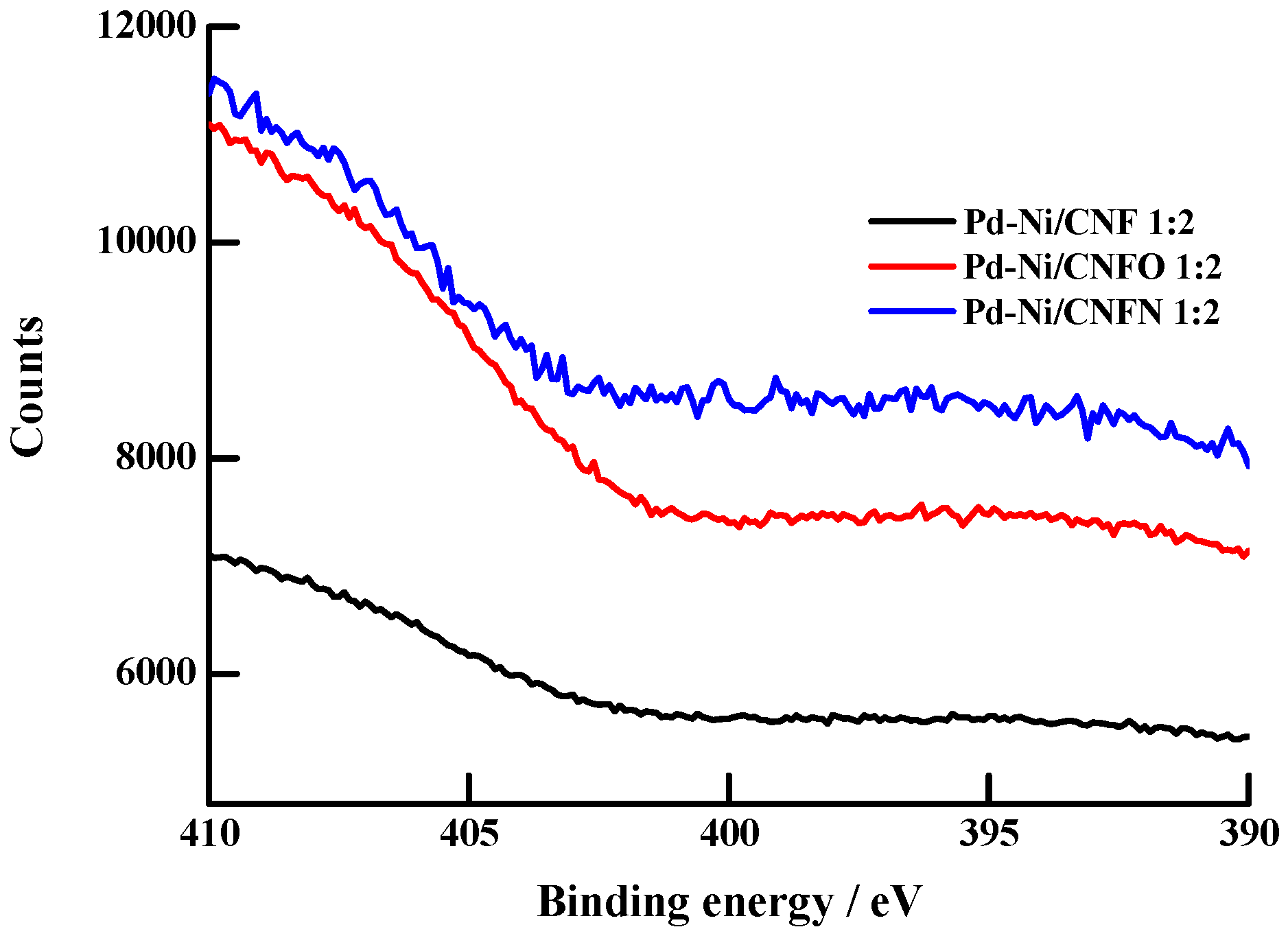
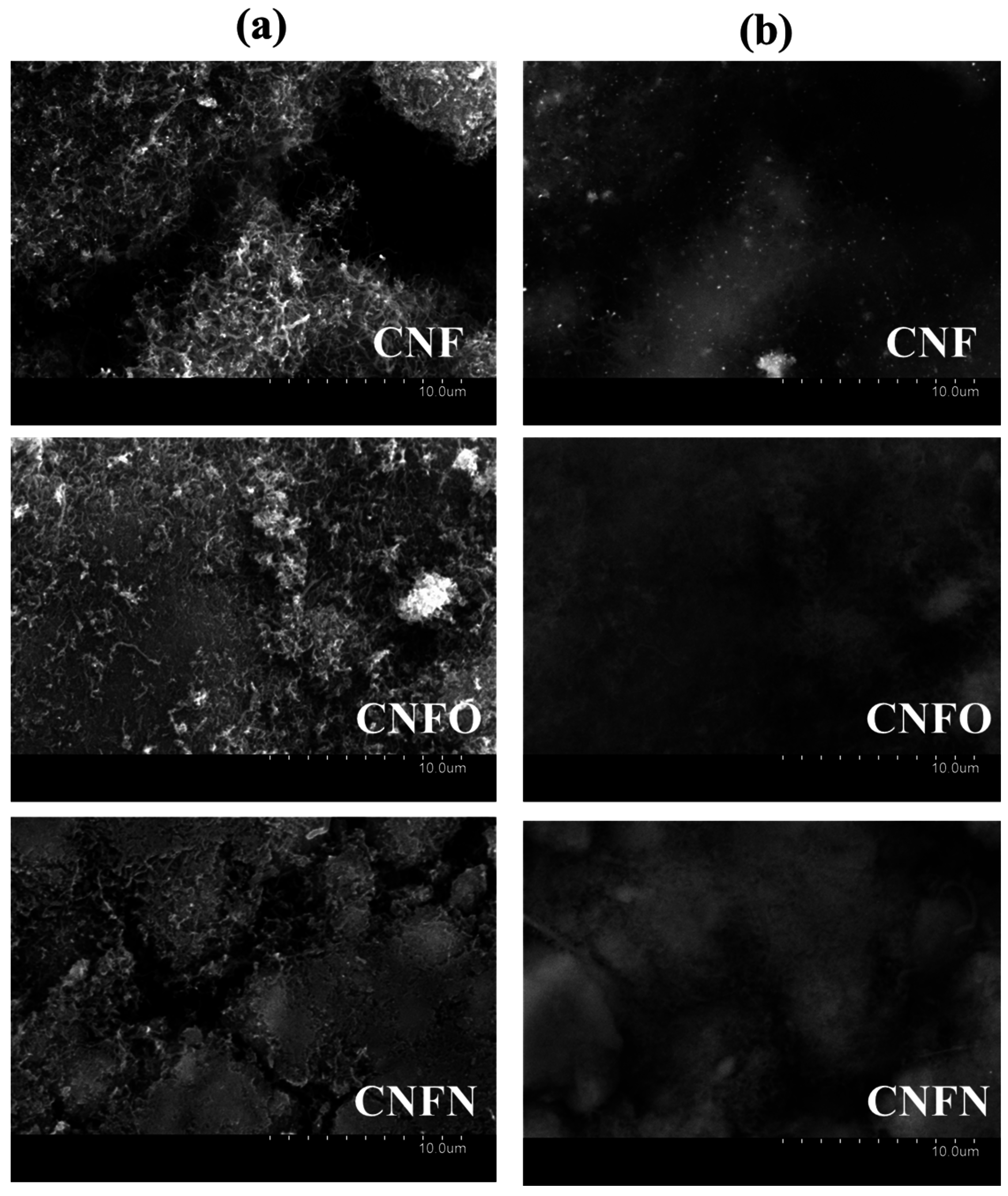
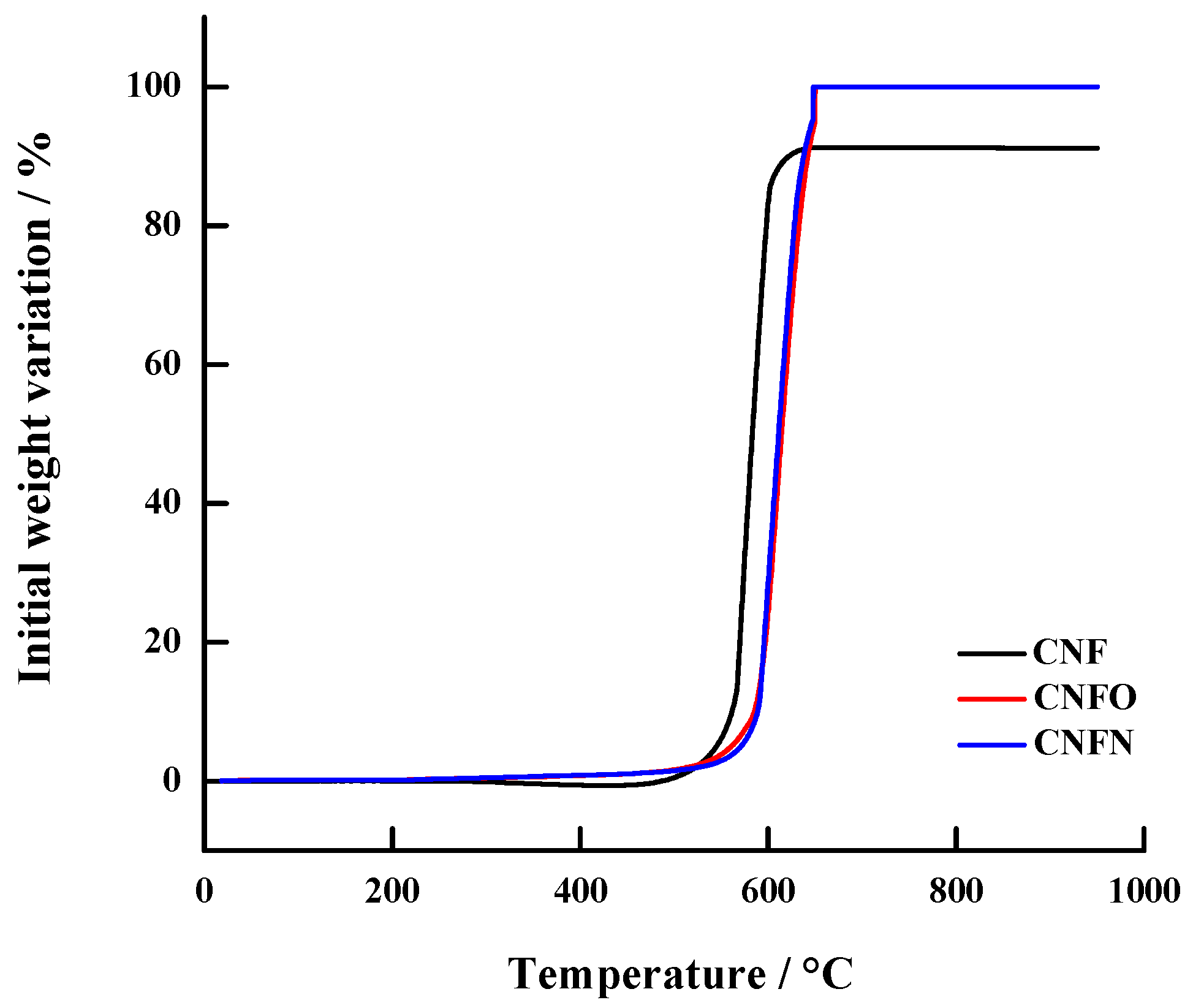
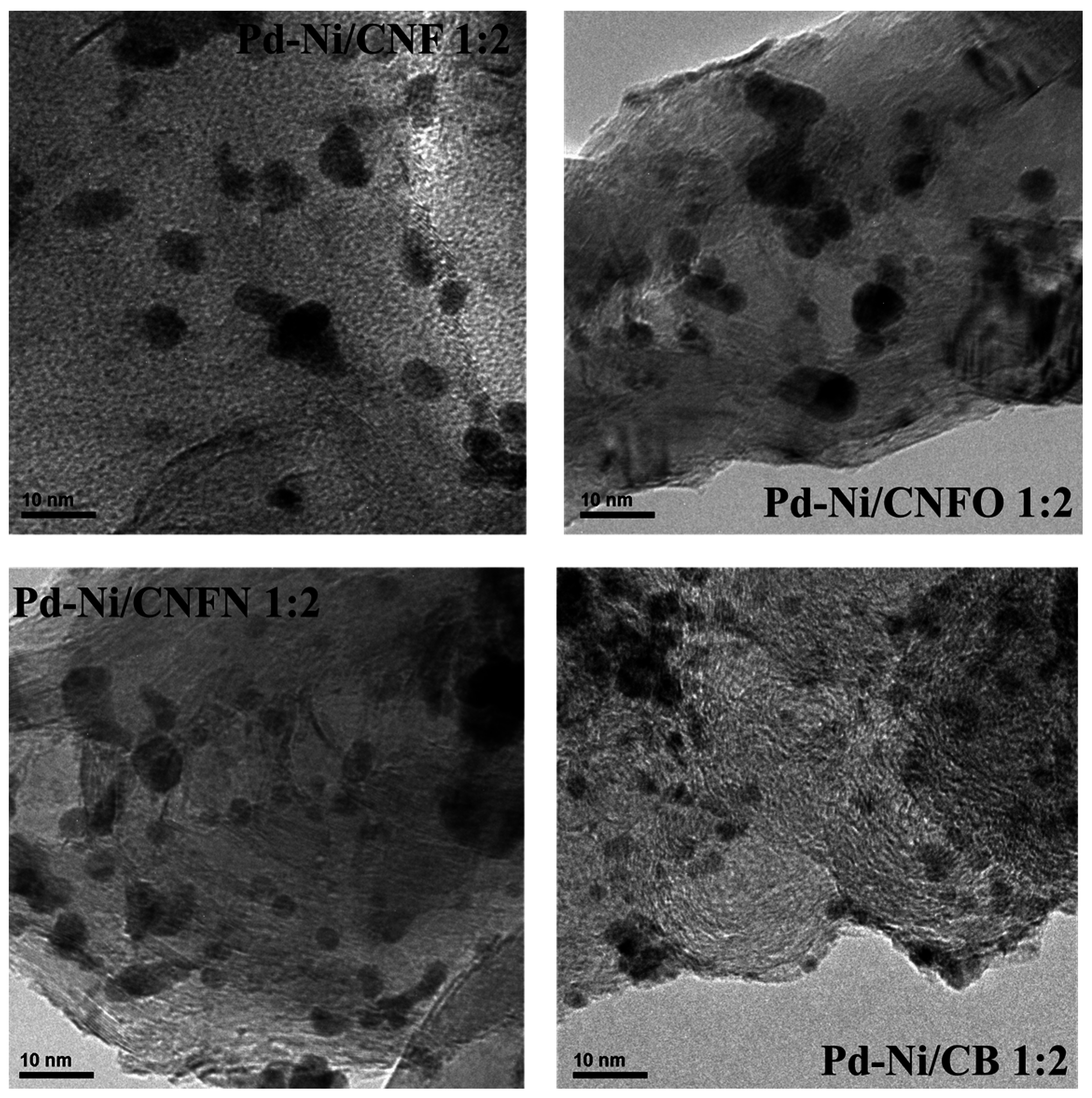
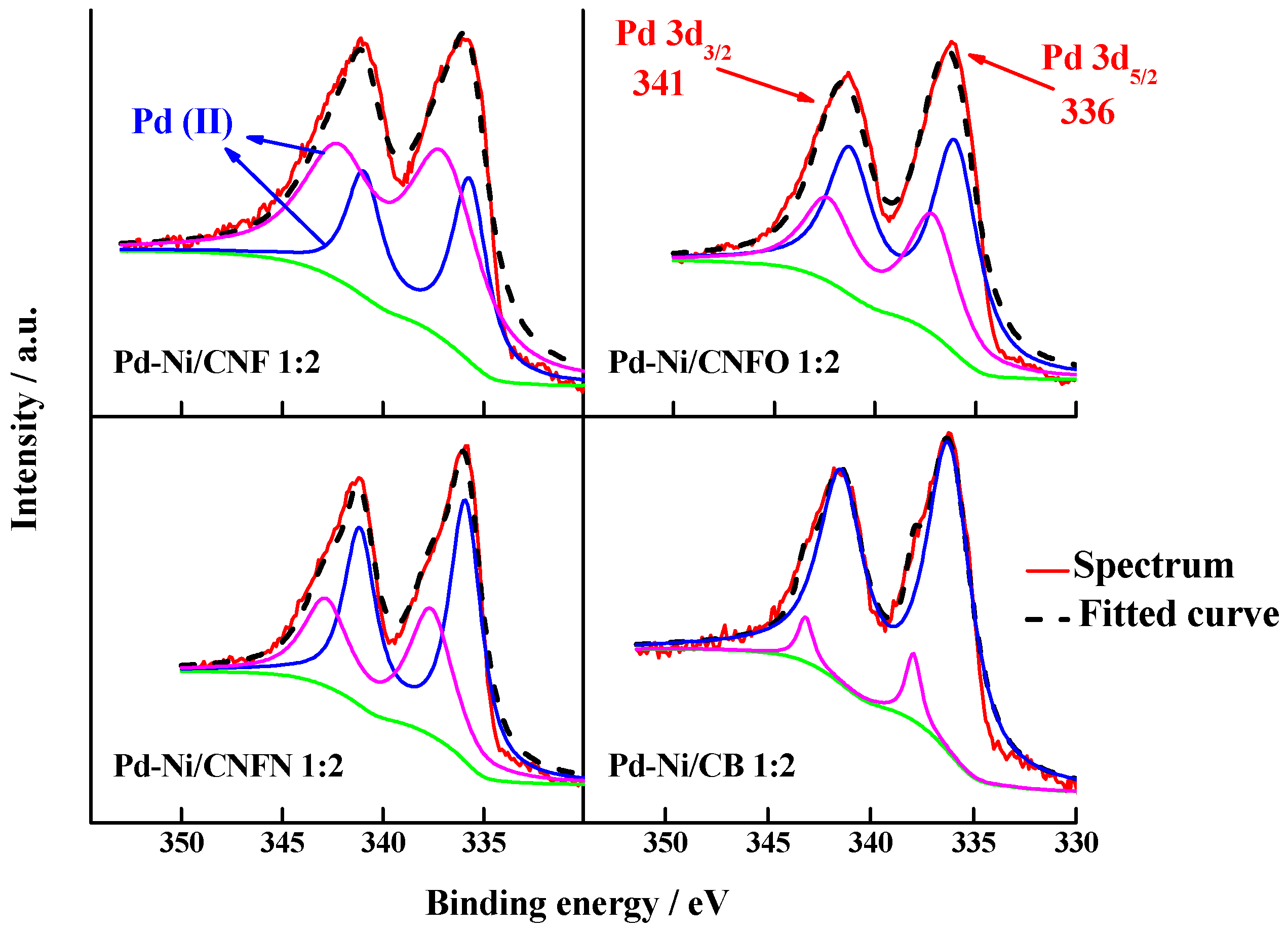



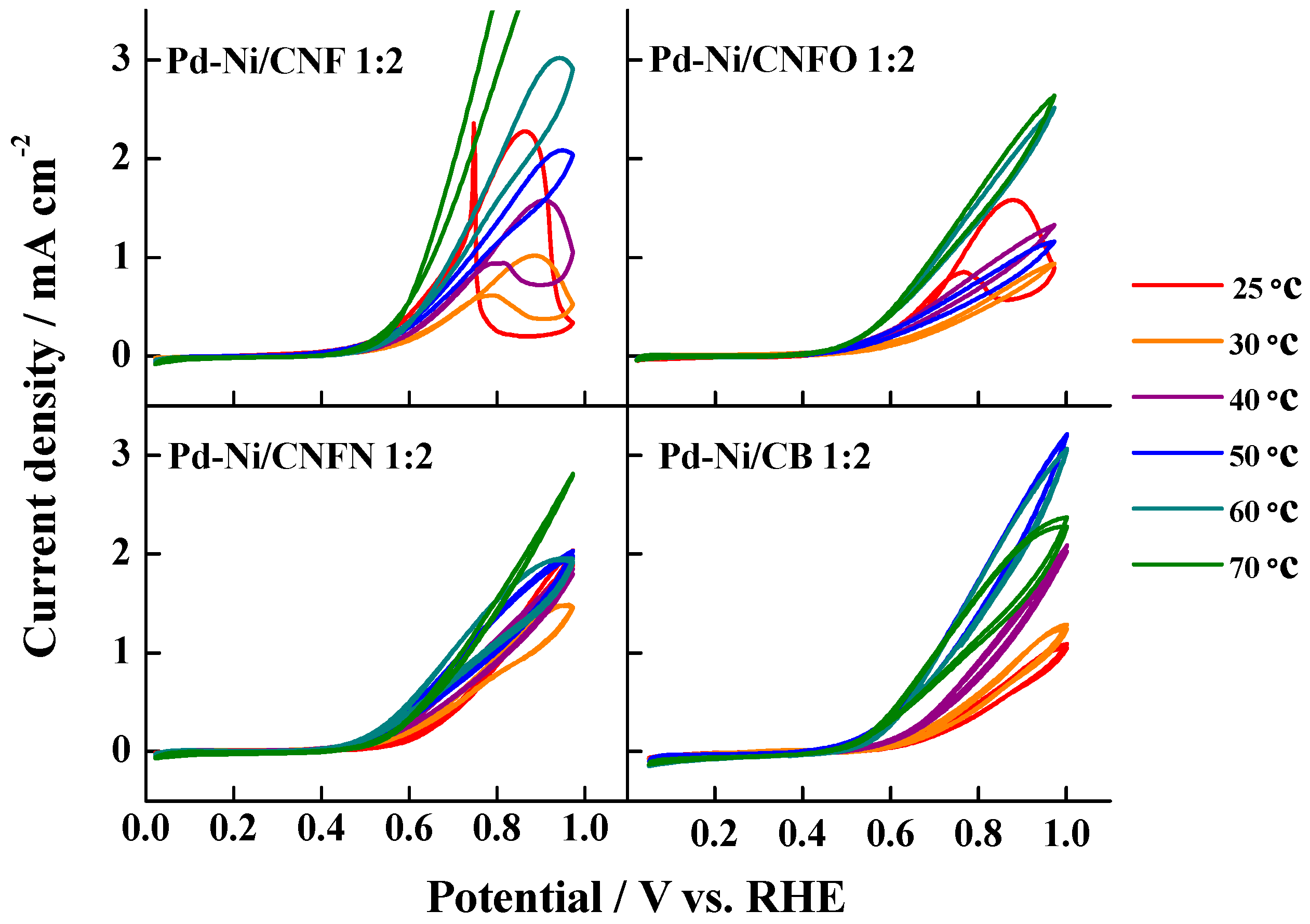
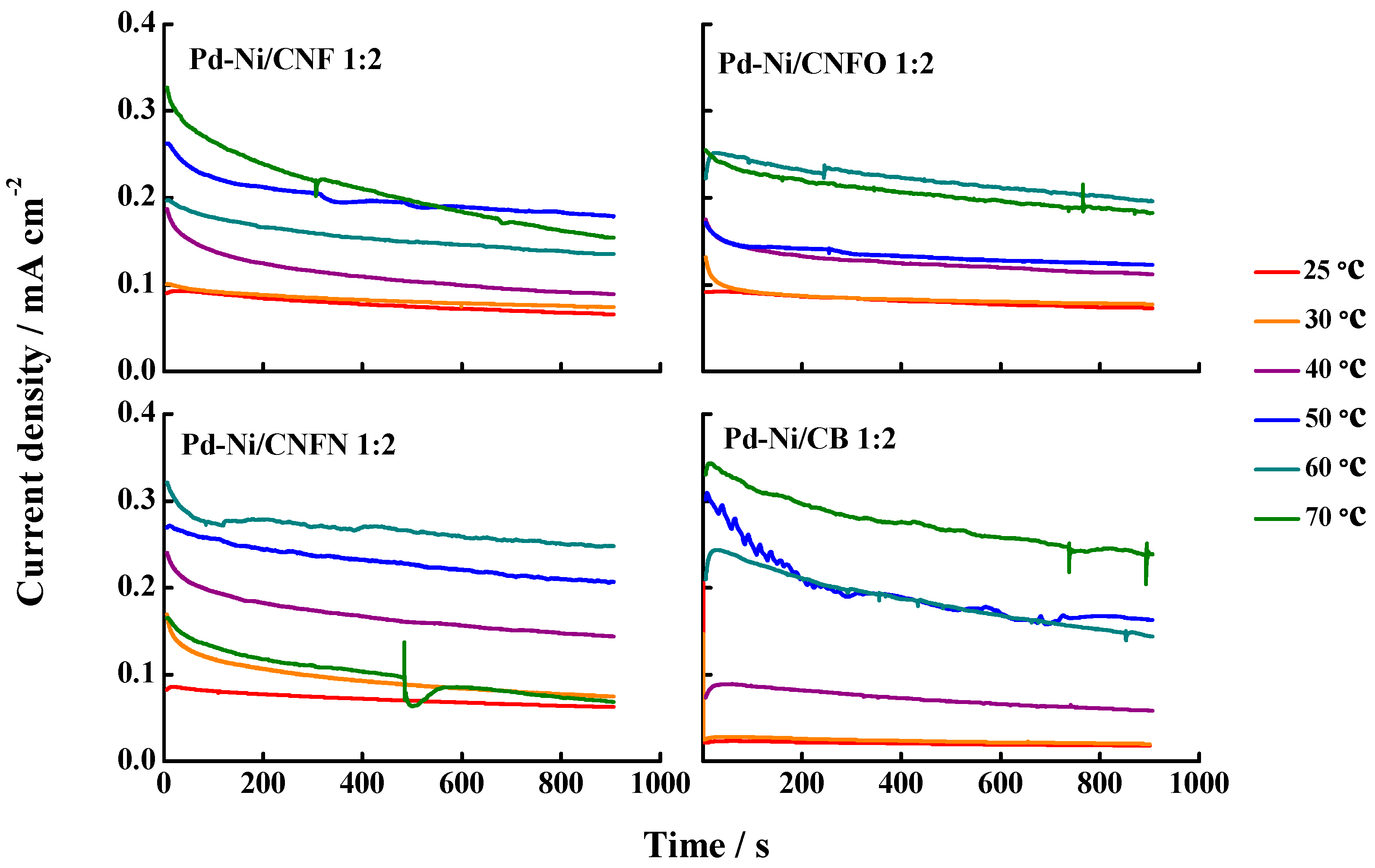
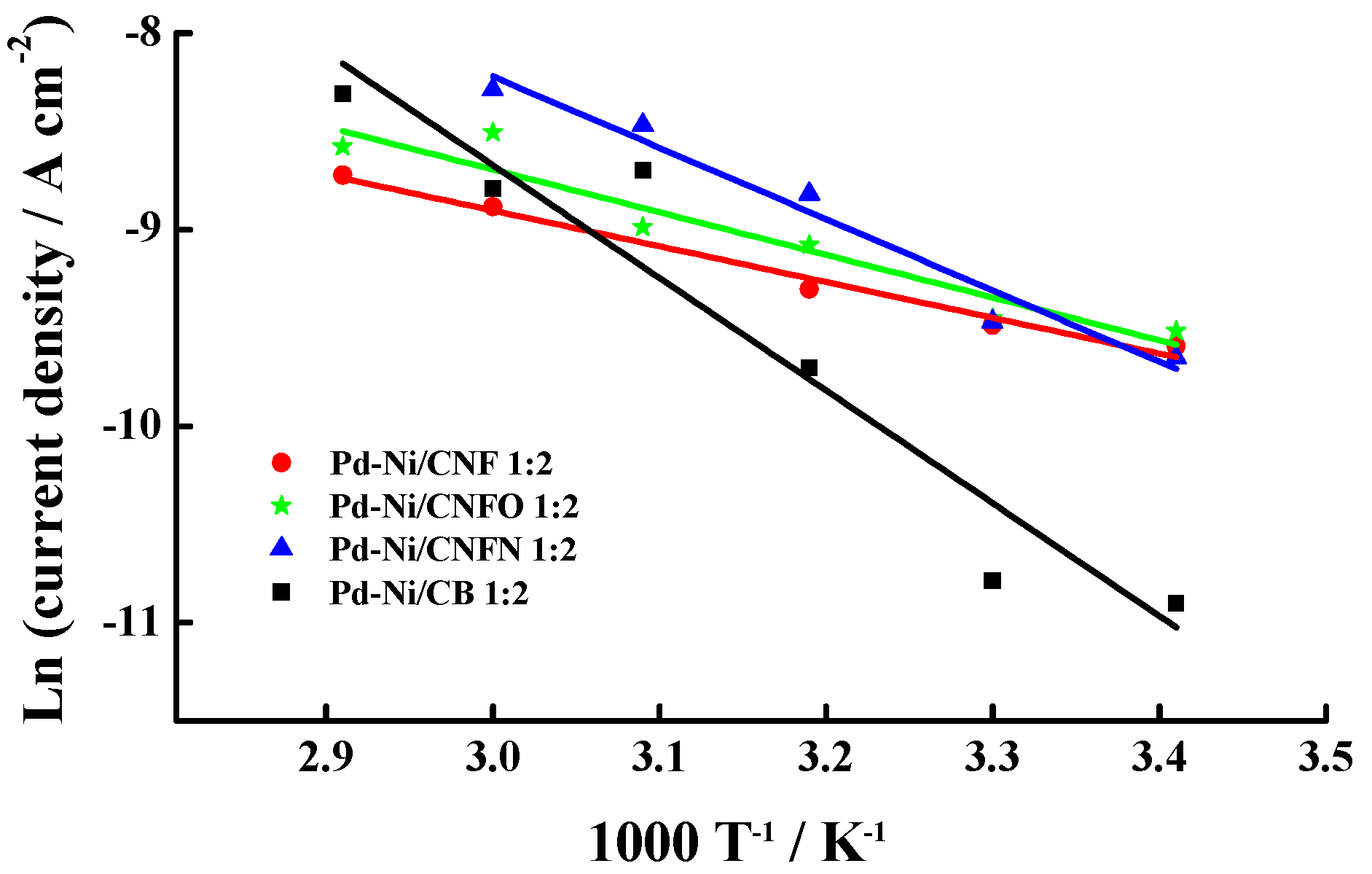
| Carbon Supports | SBET/m2·g−1 | Vtotal/cm3·g−1 | Nitrogen content/wt % |
|---|---|---|---|
| CNF | 72.1 | 0.241 | 0.03 |
| CNFO | 72.7 | 0.260 | 0.13 |
| CNFN | 72.5 | 0.280 | 0.38 |
| CB | 214.6 | 0.412 | ---- |
| Catalyst | Atomic ratio Pd:Ni | Metal content/wt % | Particle size/nm |
|---|---|---|---|
| Pd-Ni/CNF 1:2 | 33:67 | 24 | 4.1 ± 1.2 |
| Pd-Ni/CNFO 1:2 | 35:65 | 27 | 3.8 ± 1.2 |
| Pd-Ni/CNFN 1:2 | 37:63 | 18 | 3.4 ± 1.1 |
| Pd-Ni/CB 1:2 | 28:72 | 24 | 2.7 ± 0.9 |
| Catalyst | Pd | Ni | |||||
|---|---|---|---|---|---|---|---|
| Binding Energy/eV | Relative Abundance/% | Assignment | Binding Energy/eV | Relative Abundance/% | Assignment | ||
| Pd-Ni/CNF 1:2 21:79 a | 335.7 | 34 | Pd(II) | 856.9 | 54 | Ni(II) | |
| 337.0 | 66 | 863.0 | 46 | Ni(III) | |||
| Pd-Ni/CNFO 1:2 15:85 a | 336.0 | 62 | Pd(II) | 856.7 | 59 | Ni(II) | |
| 337.1 | 38 | 862.6 | 41 | Ni(III) | |||
| Pd-Ni/CNFN 1:2 16:84 a | 335.9 | 60 | Pd(II) | 857.4 | 62 | Ni(II) | |
| 337.6 | 40 | 863.7 | 38 | Ni(III) | |||
| Pd-Ni/CB 1:2 8:92 a | 336.2 | 93 | Pd(II) | 856.6 | 58 | Ni(II) | |
| 333.9 | 7 | Pd (IV) | 862.7 | 42 | Ni(III) | ||
| Catalyst | CO Eact/kJ·mol−1 |
|---|---|
| Pd-Ni/CNF 1:2 | 68 |
| Pd-Ni/CNFO 1:2 | 101 |
| Pd-Ni/CNFN 1:2 | 103 |
| Pd-Ni/CB 1:2 | 118 |
| Catalyst | Eap/kJ·mol−1 |
|---|---|
| Pd-Ni/CNF 1:2 | 15.2 |
| Pd-Ni/CNFO 1:2 | 18.2 |
| Pd-Ni/CNFN 1:2 | 30.3 |
| Pd-Ni/CB 1:2 | 47.9 |
© 2016 by the authors; licensee MDPI, Basel, Switzerland. This article is an open access article distributed under the terms and conditions of the Creative Commons Attribution (CC-BY) license (http://creativecommons.org/licenses/by/4.0/).
Share and Cite
Calderón, J.C.; Rios Ráfales, M.; Nieto-Monge, M.J.; Pardo, J.I.; Moliner, R.; Lázaro, M.J. Oxidation of CO and Methanol on Pd-Ni Catalysts Supported on Different Chemically-Treated Carbon Nanofibers. Nanomaterials 2016, 6, 187. https://doi.org/10.3390/nano6100187
Calderón JC, Rios Ráfales M, Nieto-Monge MJ, Pardo JI, Moliner R, Lázaro MJ. Oxidation of CO and Methanol on Pd-Ni Catalysts Supported on Different Chemically-Treated Carbon Nanofibers. Nanomaterials. 2016; 6(10):187. https://doi.org/10.3390/nano6100187
Chicago/Turabian StyleCalderón, Juan Carlos, Miguel Rios Ráfales, María Jesús Nieto-Monge, Juan Ignacio Pardo, Rafael Moliner, and María Jesús Lázaro. 2016. "Oxidation of CO and Methanol on Pd-Ni Catalysts Supported on Different Chemically-Treated Carbon Nanofibers" Nanomaterials 6, no. 10: 187. https://doi.org/10.3390/nano6100187






